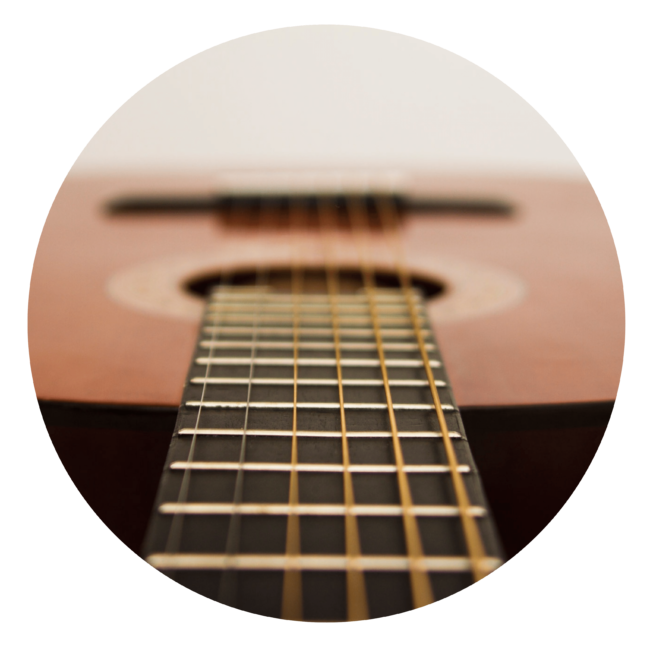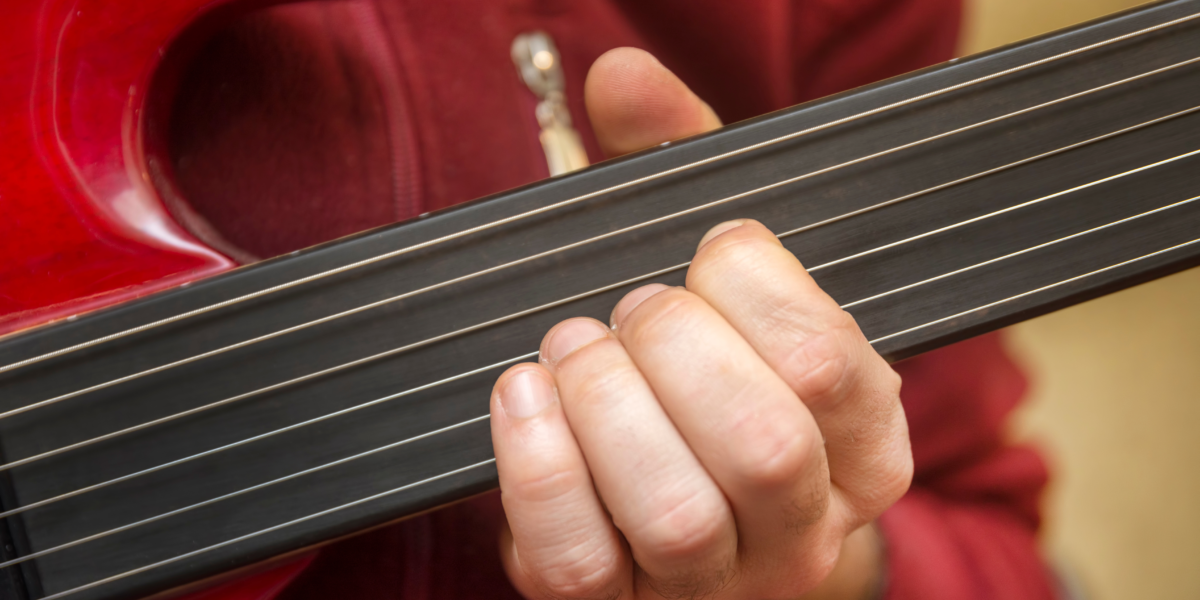What Is a Fretless Guitar and How To Play It

What is a fretless guitar, how does it sound, and why would you play one? Let’s take a look at this unique instrument.
If we think about frets, a guitar usually comes to mind. Sure there are many other instruments with frets like mandolins, bouzoukis, banjos, and dulcimers, but the guitar is the most common.
When guitar frets become worn and notched, it negatively affects the sound. But what happens if a guitar has no frets?
A fretless guitar has a beautiful tone in the hands of a master guitarist. This instrument opens the door to new techniques and notes outside the Western music scale.
What is a fretless guitar?
A fretless guitar has the same basic shape as regular acoustic, electric, or bass guitars. It just doesn’t have frets. Some guitars without frets are custom-made, while others pay a luthier to remove the frets.
As you play the fretless guitar, your fingers press into the fretboard. This allows the string to vibrate from the bridge to your fingertip.
So, who thought up this new style of guitar playing, and why was it invented?
A brief history
The first fretless classical guitars were the invention of Erkan Oğur in 1976. This Turkish musician had difficulty playing Turkish melodies within the confines of a Western music scale. So, he removed the frets to get the sound range he needed.
Other guitarists were captivated by the smooth sound of this guitar without frets. Some famous guitarists followed suit, enjoying a new tonal range.
However, a fretless style of playing guitar is still not mainstream. Some drawbacks to the fretless guitar are its complicated nature and its expense.

Why do guitars have frets?
Guitar frets divide a guitar into small sections and create a roadmap for your fingers to follow. The frets lay out octaves and the 12 semitones of the Western music scale. You can also bend strings over the frets. These visual cues make it easy to find the correct position for notes and chords.
Advantages and disadvantages of playing on a fretless guitar.
The benefits
Although a fretless guitar can be more difficult to play than a regular guitar, many guitarists love the freedom you get. Here are some of the advantages that make the extra work worthwhile.
Limitless sound range
Fretless guitars have an extra large sound range. Frets do not limit them to the standard octaves of Western music. You can go outside the normal scale to produce new sounds. A fretless guitar’s sound is soft and warm.
Smooth fingerboard for sliding
For a rich, smooth guitar, you can slide up and down without frets. There is no need to “fret out” for slide guitar and raise the action. Choose a guitar slide and allow the strings to vibrate unhindered by frets.
Flexible tuning
If you notice that you hit a note sharp or flat, simply slide the position of your fingers. This can allow you to tune your guitar on the go and find the right notes. Your audience will be none the wiser.
Creativity is king
With a fretless guitar, your creativity is free to go wild. The time spent practicing notes, and chord placement can pay off on a fretless guitar. You know the rules of playing guitar, and now you can break them.
The drawbacks
The fretless guitar can have some major advantages for master guitarists. However, it’s not all a walk in the park. There are also some disadvantages to consider.
The fretboard is sensitive
The frets on the guitar protect the fretboard. However, a fretboard on a fretless guitar is more sensitive to wear and tear. You aren’t able to bend the strings on a fretless guitar because you could end up breaking it. Instead, you have to substitute slide techniques for string bending.
Fretless guitars can be expensive
Since fretless guitars are not in high demand, it can be hard to find one in your local guitar shop. They are generally more expensive than your average guitar when you get your hands on one. Many guitarists take a regular guitar to a luthier to remove the frets. However, this process can also cost a pretty penny.
It’s easy to make mistakes
Frets set guideposts, so you know where to find the notes and chords you want. With no frets, you get more freedom to play new sounds, but it’s also easy to make mistakes. You can easily fix one wrong note by sliding your finger position until it is on the pitch. However, getting lost on the fretboard can be hard to get back on track.
The sound is soft
Fretless guitars tend to have a uniquely smooth sound. However, managing the low volume when you play for an audience can be hard. You need to mic your sound or get an electric fretless guitar you can plug into an amp.
Tips for playing on a fretless guitar.
If you already play a regular guitar with frets, you can transfer many of your skills to a fretless guitar. However, there are a few differences in how you play it. Here are a few tips for playing the guitar without frets.

1. Start with fret markings
Your guitar may not have frets, but you can still use guides to find the notes you should play. Markings can make your practice time more efficient and your performance more accurately.
Many fretless guitarists ask a luthier to add visual guides to their guitars. Luthiers can paint or notch fret markers into the neck so you can see where to place your fingers. You can have the convenience of guideposts even if you don’t have frets.
2. Adjust your techniques
With a fretless guitar, bending strings is out, and sliding is “in.” If you weren’t a slide guitarist before, you are now! Bending strings can damage the fretboard, so you need to adjust your techniques on a fretless guitar. Instead, you can slide your fingers on the fretboard to compensate.
3. Train your ear
Since there are no frets to show you where to play, you need to train your ear to find the right notes by listening. Exercising your pitch and intonation can help you avoid playing pieces out of tune and keep you on the right track.
4. Practice
As with any new skill, practice makes perfect. The more time you spend with your guitar, the better your fingers can find the right notes. Soon, you may not even need those visual fret markings. Once you get a feel for playing fretless guitar, you may never want to return to frets.
Famous guitarists who play the fretless guitar.
While fretless guitarists aren’t so common, there are a few big names that you may know.
You can listen to recordings by these famous guitarists:
- Guns ‘N Roses guitarist Ron “Bumblefoot” Thal
- The heavy metal Swedish artist, Yngwie Malmsteen
- Greg Howe from N’Sync
- Jason Becker from the band Cacophony
- The composer and filmmaker, Ned Evett
Listening to other fretless guitarists who have mastered this technique can help you perfect your skills.
Should beginners try fretless guitar?
You should learn the rules before breaking them. You should know a regular fretted guitar like the back of your hand for fretless guitars.
Learning guitar can be difficult enough when you have frets to show you where to play the notes. A fretted guitar is less frustrating for beginners to learn and allows you to master skills quickly.
Frets make it easier for beginning guitarists to learn notes and chords. You can see and feel where your fingers need to be. Also, chord charts are almost impossible to read without frets. Once you master a fretted guitar, you can transfer your knowledge and skills and learn how to play a fretless guitar.
Final words.
A guitar without frets may be tricky to play. However, its smooth, vocal sound quality is hard to beat. When you learn how to play basic guitar skills, you can pick up a fretless guitar. This new challenge can help you perfect your guitar techniques and expand your song repertoire.
A guitar without frets gives you unlimited sound and allows your creativity to go wild.
If you are a beginner at learning the fretless guitar, the best way to start is to learn guitar basics. You can do this from the comfort of your home with an app to guide you. The Simply Guitar app offers a two-week free trial. Try it at no cost and see if it’s right for you!









